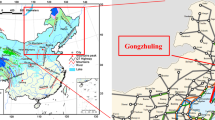Abstract
Frost heave is a long-recognized issue contributing to the railway track upheaval in cold regions. Generally, frost heave is believed to happen in the subgrade layer of transportation infrastructure, referred to as the volume expansion of frozen soils, which are susceptible to frost action with the presence of moisture. The aggregate layer, such as highway base course or railroad ballast, is believed not to be prone to the frost heave due to its large void ratio and low capability to hold moisture content. However, recent reports around the world, such as Norway, USA, China, and Japan, etc., indicate the frost heave does happen in the ballast layer even when the moisture content is low. Existing literatures, which often believe track upheaval should not happen on aggregate like ballast, cannot well explain the recently observed phenomenon. In this study, the researchers conduct a series of laboratory experiments aiming to identify the possible reason that cause ballast frost heave in a well-controlled environment. Clean ballast is prepared with different moisture conditions, including half submerged condition and fully submerged condition. The growth of ice and movement of particles are tracked and qualified through image analysis. The findings from this study provide evidence to prove the effect of ice formation on ballast and would help to explain the root cause of ballast frost heave.
Access this chapter
Tax calculation will be finalised at checkout
Purchases are for personal use only
Similar content being viewed by others
References
Rempel AW, Wettlaufer JS, Worster MG (2004) Premelting dynamics in a continuum model of frost heave. J Fluid Mech 498:227
Taber S (1930) The mechanics of frost heaving. J Geol 38(4):303–317
Akagawa S, Kodama N (2005, January) Frost weathering in rocks and mortar. In Alaska Rocks 2005. In: The 40th US symposium on rock mechanics (USRMS). American Rock Mechanics Association
Beskow G (1935) Soil freezing and frost heaving with special application to roads and railroads. Swed Geol Soc Ser C No. 375, 26th year book No. 3 (translated by J.O. Osterberg, Northwestern Univ., 1947)
Bronfenbrener L, Bronfenbrener R (2010) Modeling frost heave in freezing soils. Cold Reg Sci Technol 61(1):43–64
Fasano A, Primicerio M (1984) Freezing in porous media; a review of mathematical models. Appl Mathematics Technol Teubner, pp 288–311
Wettlaufer JS (1999) Ice surfaces: macroscopic effects of microscopic structure. Phil Trans R Soc Lond A 357:3403–3425
Henry KS (1996) Geotextiles to mitigate frost effects in soils: a critical review. Transp Res Record 1534(1):5–11
Nurmikolu A (2005) Degradation and frost susceptibility of crushed rock aggregates used in structural layers of railway track. Tampere University of Technology
Sheng DC, Zhang S, Niu F, Cheng G (2014) A potential new frost heave mechanism in high-speed railway embankments. Géotechnique 64(2):144–154
Akagawa S, Hori M, Sugawara J (2017) Frost heaving in ballast railway tracks. Procedia Eng 189:547–553
Arema LMD (2013) American railway engineering and maintenance-of-way association. Manual for railway engineering
Acknowledgements
This research is partially funded by the new faculty startup fund provided by the College of Engineering and Computer at the University of South Carolina. The opinions expressed in this article are solely those of the authors and do not represent the opinions of the funding agencies.
Author information
Authors and Affiliations
Corresponding author
Editor information
Editors and Affiliations
Rights and permissions
Copyright information
© 2022 The Author(s), under exclusive license to Springer Nature Switzerland AG
About this paper
Cite this paper
Guo, F., Qian, Y., Wang, Y., Rizos, D.C., Shi, Y. (2022). Laboratory Study on Frost Heave of Ballast. In: Tutumluer, E., Nazarian, S., Al-Qadi, I., Qamhia, I.I. (eds) Advances in Transportation Geotechnics IV. Lecture Notes in Civil Engineering, vol 166. Springer, Cham. https://doi.org/10.1007/978-3-030-77238-3_37
Download citation
DOI: https://doi.org/10.1007/978-3-030-77238-3_37
Published:
Publisher Name: Springer, Cham
Print ISBN: 978-3-030-77237-6
Online ISBN: 978-3-030-77238-3
eBook Packages: EngineeringEngineering (R0)




